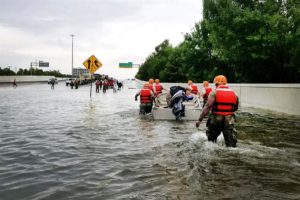“When I think about resilience at the community level,” Lourdes Rodriguez says, “I think about communities that understand that the conditions creating adversity are bigger than an individual.”
 In physics, resilience is an object’s ability to bounce back into its original form after sustaining a shock. In communities, it means something much more.
In physics, resilience is an object’s ability to bounce back into its original form after sustaining a shock. In communities, it means something much more.
Wendy Ellis, project director of the Building Community Resilience (BCR) collaborative at the Milken Institute of Public Health at George Washington University, associates community resilience with an ability to “bounce forward”—moving forward, in the wake of disasters like Hurricane Harvey and Hurricane Katrina, towards more equitable living conditions.
This week on Into the Fold, Ellis and Lourdes Rodriguez, director of the Center for Place-Based Initiatives at Dell Medical School, talk with host Ike Evans about what community resilience really means—and how individuals and institutions can come together to achieve it.
Bouncing Forward: Avoiding a Return to Inequity
Two kinds of disaster, or shock, can be used to talk about a community’s resilience: “acute” (e.g. Hurricane Katrina), and “chronic”. According to Rodriguez, the latter category consists of “disasters of the everyday”—the social, economic and structural sources of adversity that persist over time.
“I think about acute disasters as a magnifying glass that helps us understand the tender points…that are putting communities in vulnerable positions,” Rodriguez says.
Acute disasters reveal not only the true severity and extent of chronic disasters, but the deep-seated attitudes and cultural beliefs that sustain them as well. When survival is treated as something reserved for the deserving alone, the prejudices that stratify community spaces—everything from housing to local retail and clinical services—become startlingly clear. Even empathy, Ellis says, is rationed.
“If we think about addressing resilience as something that people have to deserve,” Rodriguez says, “then we are undermining this idea that communities can bounce forward.”
If resilience is to be achieved, community leaders can’t afford to ignore the vast gaps and inequalities that leave individuals unprotected. “At the end of the day, when we’re talking about resilience, we’re looking through the lens of equity,” Ellis says. “So resilience does equal equity, and there’s no resilience with disparity.”
Building Community Resilience is “Everybody’s Job”
Once the lens of equity is in place, organizations that wish to lead resilience-building efforts strive for approaches that, as Rodriguez puts it, are “more relational than programmatic.” That perspective, which liberates projects from the bureaucratic constraints of a step-by-step approach, inspired the Center for Place-Based Initiatives to put out a “Call for Ideas.”
The call implores “all Central Texans” to submit ideas for improving the health of their communities. “We’re trying to make room at the center for folks that are not necessarily part of generating knowledge and problem-solving to come alongside us as partners,” Rodriguez explains. When the members and institutions of a community collaborate, the underutilization of resources due to missed connections or poor circulation becomes less likely.
This proved to be the case for the Faubion School in Portland, Oregon, where 90 percent of students live at least 200 percent below the federal poverty level and 20 percent are homeless. By establishing a partnership between the school, Concordia University and healthcare provider Kaiser Permanente, the BCR Collaborative was able to coordinate services and supports across all three institutions—bringing art classes, education students and trauma-informed trainings for staff.
In seven years, Faubion School has seen reduced absenteeism rates, behavioral problems and suspensions—with parallel increases in teacher retention levels. The intervention’s impact is a virtuous cycle—operating at the community level to touch the lives of individuals, who in turn become more active in their communities.
“Building community resilience isn’t only for folks that are in public service, or that are in academia, or that are in the public world,” Rodriguez says. “It is everybody’s job and everybody’s responsibility.”
Learn more about our podcast and check out other episodes!
